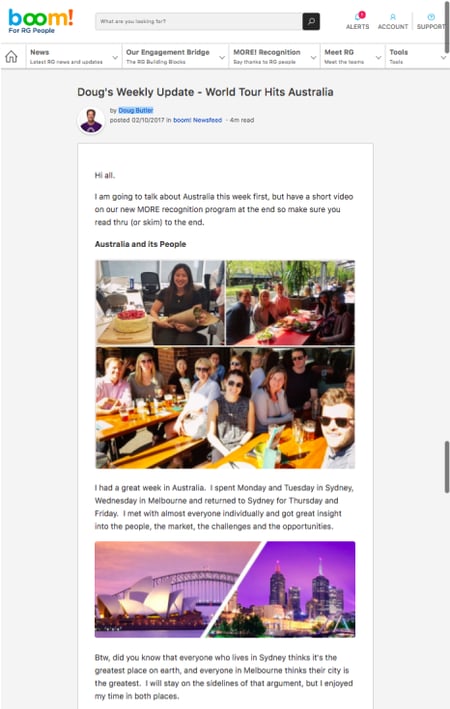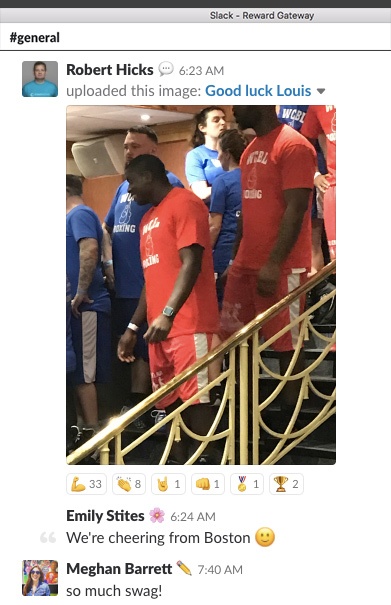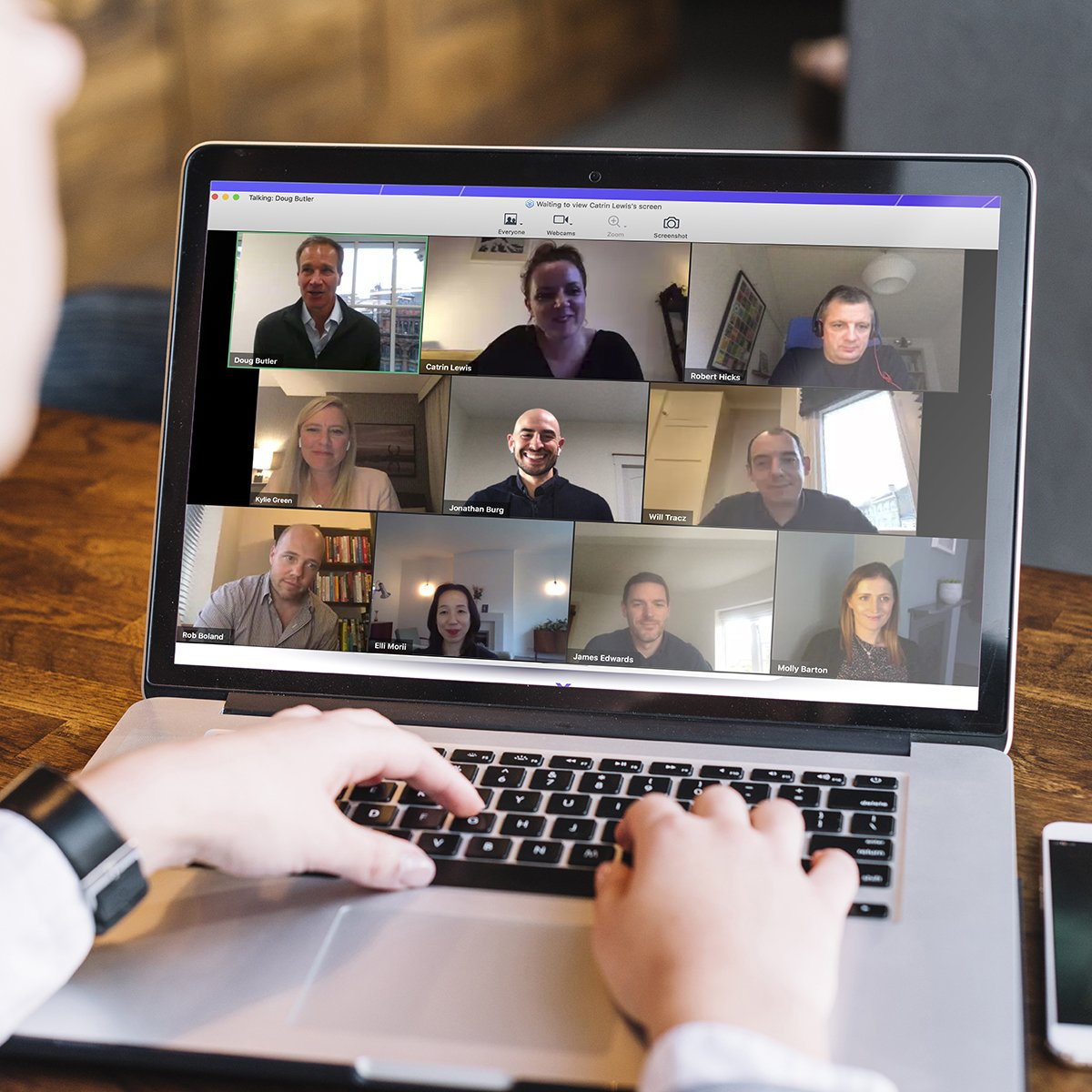One recurring issue that I hear employees and employers all over the world talking about is the disconnect between leaders and their people. You’ve probably heard people say, “My manager doesn’t tell me anything,” “What goes on behind closed boardroom doors doesn’t affect me,” or “I don’t even know what our CEO looks like.”
These are all red flags that indicate something is wrong with the level of communication happening in your business. It is not ok for leaders to be invisible or inaccessible.
In an age where information is critical for how people do their jobs, leaders need to be putting themselves out there in front of their employees, and intentionally and proactively initiating communication.
Think about how you respond when you feel out of the loop or like you’re missing out. It’s so easy to disengage - which is not what we want our employees to be doing. Worse, employees who are misinformed are more at risk of making mistakes.
The good thing is, I’m coming across more leaders who are willing to bridge the communications divide and work on improving leadership visibility. Here are some simple things you might do to make the Leadership Team more visible to your employees.
Be where people can see you
This probably seems so simple that it’s silly that I have to mention it but if your employees can’t see the leadership team, they’ll remain invisible and detached. If they’re all sitting in separate offices, or only ever work from one location, then they immediately miss out on the opportunity to build relationships and increase their influence with their employees.
I confess that I used to have my own office and I loved it. The first time we ever changed the office design to an open-plan workspace, I really struggled with the noise and the distraction, and ended up taking work home with me if I needed a space to stay focussed and productive. To say the change in work environment was difficult is an understatement.
But years on, I would have it no other way.
I’ve seen the benefit of being able to work next to different people in different departments every day; I relish the information I get about what is happening in their area of the business. I get insight into the struggles and frustrations my people experience because I see and hear them firsthand (sometimes through loud conversations or disgruntled curse words!). This insight is something most directors never get access to because they’re physically too far removed from their people.
Without the confines of a separated office, I can look up and see my team and — perhaps more importantly — they can see me.
My diary is usually booked out for meetings, but nothing stops an employee tapping me on the shoulder to ask a quick question. And when I do need to remove myself from the buzz in our Sydney office, I book out one of our workspaces to do this.
If an office redesign is out of the question, hot-desking or temporarily working out of a different office allows people to spend time with members of your Leadership Team, which is a simple and cost-effective way to remove the physical barriers between leadership and staff.
Meet your people where they are
When our CEO, Doug, was first appointed to the role, one of the first things he did was visit each Reward Gateway office. He called it his "World Listening Tour" and he flew to each of our locations with the aim of meeting as many RG employees as his schedule would allow, and listening to them to understand what was happening in the business.
I understand that not every people leader can afford the time and expense of traveling to every national or global location, but that shouldn’t stop your leaders from connecting with their people, no matter the distance between them. For example, new starters "meet" Doug on their first day, via video.
Use technology to bridge the divide
Technology can be a great enabler when it comes to increasing visibility of the Leadership Team.
Along with all the other members of our leadership team, Doug also dedicates part of his week to writing a weekly blog post, which is published on boom!, Reward Gateway’s engagement hub.

Our leadership blog posts normally contain a summary of what we’ve been personally working on, who we’ve been working with (this is a great opportunity to give employee recognition to some our team members in front of the rest of the business), and what impact that will have to the employees who aren’t necessarily in our department.
This continual, conscious linking of leadership activities with day-to-day frontline work (and vice versa) and having to write about it means we leaders are accountable for sharing information with the greater business. The great thing is, we have an employee communications platform that is purpose-built to achieve this and also solicits responses and feedback from the staff who are reading that information.
Learn more about how to improve employee communications in your company »
Engage with employees online - respond, like, comment and share
While getting leaders to post and share information online is great, it’s only one part of the process.
Leaders should also be proactively engaging in conversations, whatever the platform may be, whether it’s in a group chat channel on Slack or on an internal blog post.
I especially love seeing members of our Leadership Team comment on company-wide achievements, and give virtual high-fives when teams around the globe share news about new sales, renewed deals, implementations, high NPS scores, and even personal achievements like fundraising or sporting events. The example below is a post from our Group HR Director, Rob, wishing one of our employees luck for a fundraising boxing match.

Empower leaders with specific, special ways to recognise employers
At RG, managers have "Game Changers" awards that they can give to anyone in their team at their discretion. We also have Leadership Amazing Awards (or LAAs) that anyone in the Leadership Team can give to someone who has done a truly exceptional job. The award is reserved for moments when someone exemplifies all RG values over the course of a project and delivers something bigger than the sum of its parts. This kind of work is usually challenging and lonely, so it makes sense to award our people and celebrating the effort and outcome.
Having this special layer of recognition and reward gives the Leadership Team another opportunity to get in front of employees and communicate what behaviours and values we think are important. It also reminds our employees that what they do is being seen and noticed by the entire company.
Don’t be afraid to show personality

I think the image of CEOs and directors only ever wearing stiff business suits and communicating behind closed doors is slowly but surely fading. I welcome the day that every employee can see and hear their leaders candidly, and appreciate the humour or quirkiness that makes all of us human. Part of that open and honest communication means being brave enough to be exactly who we are, even if it may seem silly to some of our people.
Leaders might be a bit wary of putting themselves out there, but I think having the courage to show up as exactly who you are gives your employees permission to do the same, and to approach their job as their whole self. What an awesome way to approach engagement! When Doug couldn't join us for a Australian "town hall" event he sent a video instead, complete with Australian slang terms. He isn’t afraid to sound or seem a bit silly, because by combining technology with a human and personal element, he showed our team that he was willing to put in the effort and connect with us, even if he couldn’t physically be there.
By adopting this approach in how we communicate, leaders automatically become more welcoming and visible.

 Kylie Green
Kylie Green



